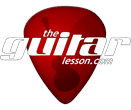Tapping the guitar means you produce sounds by tapping the string at any fret, instead of plucking the strings. Guitar tapping can be carried out with just one hand, or both hands at the same time, and can be used to give your music a more percussive feel, therefore rhythm and timing are very important.
Tapping has existed in some form or another for centuries, basically ever since the guitar has existed.
Eddie Van Halen was the person responsible for popularizing the tapping technique for the modern audience, influencing many guitarists and musicians. Most people think Eddie invented tapping, which is not true, although he is credited for bringing it into modern music.
To get the most out of tapping, you will use an overdriven electric guitar (distortion). If you're using a lot of distortion, you will hear unwanted strings/notes ring out because of touching other strings by accident, and the force of the tapping causing the fretboard to vibrate. This means that you will have to put great emphasis on muting the strings you are not tapping. You can do this by using palm muting the bass strings, and finger muting the treble strings you are not tapping.
Tapping with One Hand
Don’t let the name fool you, you use both hands during one-handed tapping, since you will be fretting the strings as well with your fretting hand, otherwise, you would always be pulling off to the open string. If know how to do a hammer-on and a pull-off, you already know the basics of tapping the guitar.
The correct way to carry out one-handed tapping is the following:
- Use the index or middle finger of your plucking hand to sound the first note on a string by sharply hammering onto it once
- Pull off to a lower note held by one of the left hand fingers
- you can then pull off or hammer on to another note with your fretting fingers, creating different sequences.
- Keep your taps as coordinated as possible, try not to touch other strings.
- Play around with the gain level. Setting the gain higher will result in the loudest and prominent sounds becoming dominant, in other words, the notes you tap onto.
- As with all of the new guitar techniques you learn, start out slow and speed up gradually.
The most common tapping sequence one involves rapid sequences. Here are a couple of examples, note that F denoted the fretting hand, and P denotes the picking hand, so the hand you're tapping with:
- Tap (P) —> pull-off (P) —> pull-off (F)
- Tap (P) —> pull-off (P) —> hammer-on (F) —> pull-off (F)
- Tap (P) —> pull-off (P) —> hammer-on (F)
- Tap (P) —> pull-off (P) —> pull-off (F) —> hammer-on (F)
Tapping with Two Hands
Two-handed tapping is more rarely found in rock music than one-handed tapping. You can use tapping with both hands to create counterpoint music on a guitar, thereby make music written for keyboard instruments as well.
When you tap with both hands, your plucking hand usually plays the melody on the treble strings (higher in pitch), while your fretting hand plays the accompaniment. Mastering the technique of tapping will greatly increase the flexibility of the instrument, in that it makes it possible to play more types of music on a guitar.
What notes do you tap?
This is a very good question! Mostly you'll be tapping arpeggios of chords, but you can of course tap scale notes as well.
Tapping exercise
Here is a basic tapping exercise for beginners, as well as the tablature for it:
- Fret the high E string at fret 7.
- Tap onto fret 14 with a plucking hand finger and pull off to fret 7.
- Now while keeping fret 7 held down, tap onto fret 10 with another fretting finger
- Repeat
- Move around to fret 15, fret 12 with your picking hand as well

